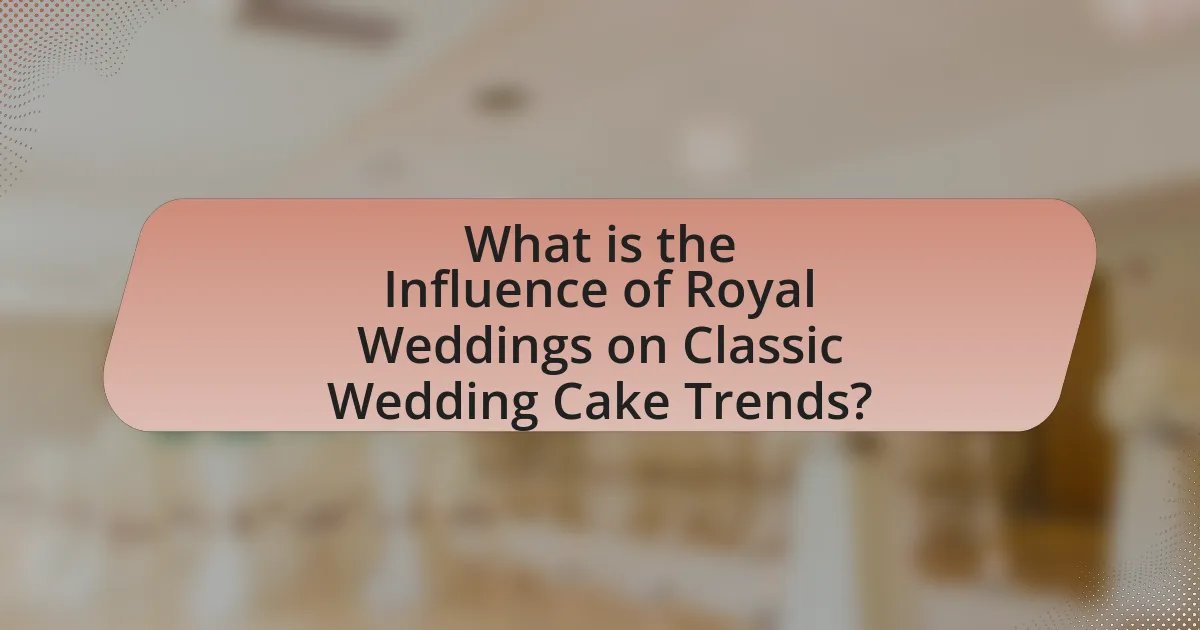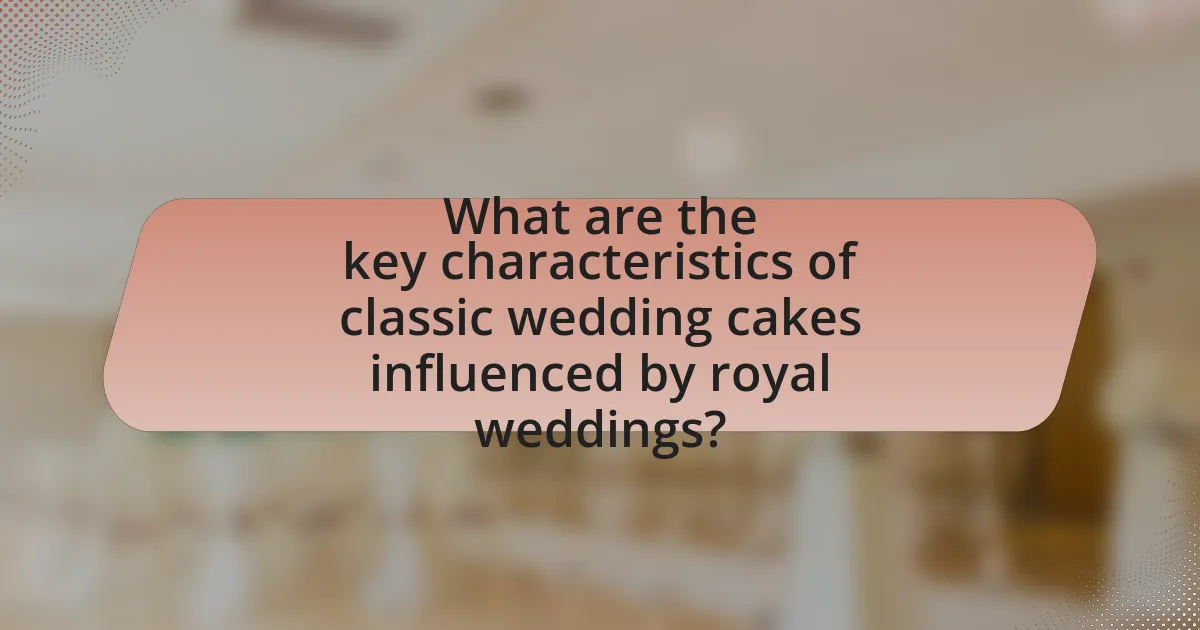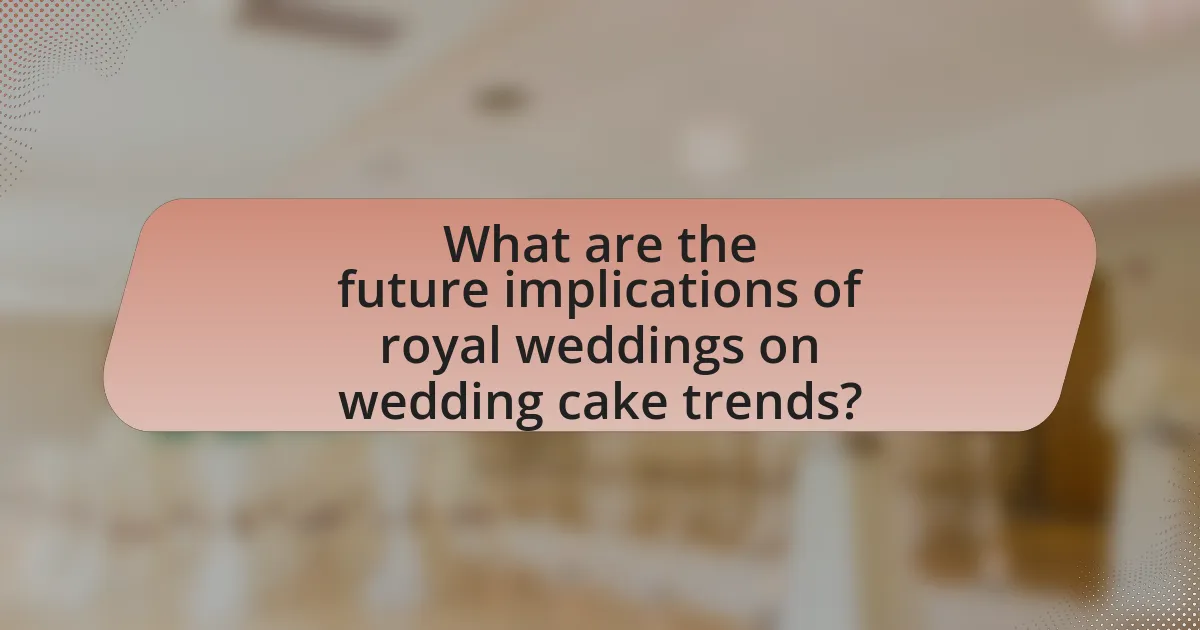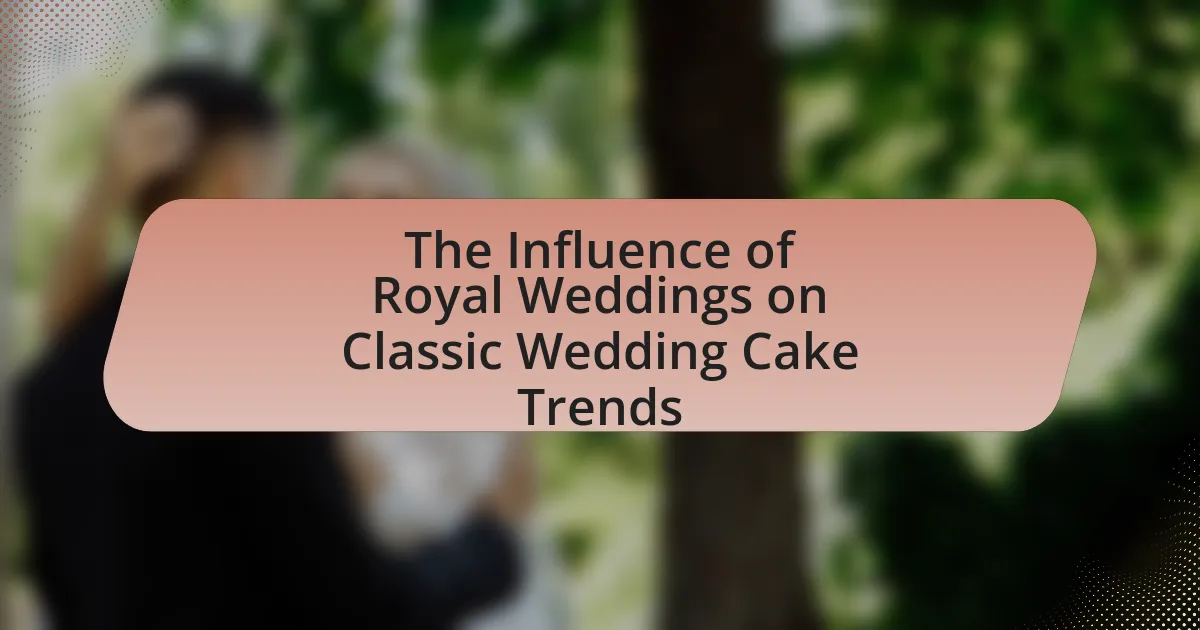The article examines the significant influence of royal weddings on classic wedding cake trends, highlighting how these high-profile events set standards for design, flavor, and presentation. It discusses historical examples, such as Queen Victoria’s tiered cake and the modern interpretations seen in the weddings of Prince William and Kate Middleton, as well as Prince Harry and Meghan Markle. Key elements adopted from royal weddings include multi-tiered structures, intricate decorations, and unique flavors, which have become popular among contemporary couples. The article also explores the role of media in shaping public perception and consumer behavior regarding wedding cakes, as well as practical tips for couples looking to incorporate royal-inspired designs into their celebrations.

What is the Influence of Royal Weddings on Classic Wedding Cake Trends?
Royal weddings significantly influence classic wedding cake trends by setting high standards for design, flavor, and presentation. For instance, the wedding cake of Prince William and Catherine Middleton in 2011 featured a traditional fruitcake layered with intricate floral decorations, which sparked a resurgence in interest for classic flavors and elaborate designs among couples. Similarly, the 2018 wedding of Prince Harry and Meghan Markle introduced a modern twist with a lemon elderflower cake, inspiring many to incorporate unique flavors into their own wedding cakes. These royal events not only showcase luxurious cake styles but also drive trends that reflect both tradition and innovation in the wedding industry.
How have royal weddings historically shaped wedding cake designs?
Royal weddings have historically shaped wedding cake designs by introducing elaborate styles and trends that reflect the grandeur of the occasion. For instance, Queen Victoria’s wedding cake in 1840 was one of the first to feature a tiered design, which became a standard in wedding cakes thereafter. This cake was adorned with intricate decorations and set a precedent for future royal cakes, influencing societal expectations for wedding cake aesthetics. Additionally, the wedding of Prince William and Kate Middleton in 2011 showcased a modern interpretation of traditional elements, incorporating both classic and contemporary designs, which further inspired couples worldwide to adopt similar styles. These royal events have consistently elevated the significance of wedding cakes, making them a central feature of wedding celebrations and influencing their design through opulence and creativity.
What specific elements from royal weddings have been adopted in classic wedding cakes?
Royal weddings have influenced classic wedding cakes through the adoption of multi-tiered designs, intricate decorations, and the use of symbolic elements. Multi-tiered cakes, often seen in royal ceremonies, create a grand presentation and have become a staple in traditional weddings. Intricate decorations, such as lace patterns and floral motifs, reflect the elegance associated with royal events and are now commonly incorporated into wedding cake designs. Additionally, symbolic elements like the use of specific colors or themes that represent the couple’s heritage or story have been inspired by royal traditions, enhancing the personal significance of wedding cakes.
How do cultural traditions from royal weddings influence cake trends?
Cultural traditions from royal weddings significantly influence cake trends by setting standards for design, flavor, and presentation. For instance, the elaborate multi-tiered cakes seen at royal weddings, such as the iconic fruitcake served at the wedding of Prince William and Kate Middleton in 2011, have inspired couples to opt for similarly grand designs. Additionally, the incorporation of unique cultural elements, like the use of traditional flavors or decorations that reflect the couple’s heritage, encourages bakers to innovate and diversify their offerings. This trend is supported by the fact that royal weddings often receive extensive media coverage, showcasing these cakes to a global audience and prompting a desire for similar opulence in personal celebrations.
Why are royal weddings considered trendsetters in the wedding industry?
Royal weddings are considered trendsetters in the wedding industry because they showcase opulence, unique styles, and innovative ideas that influence public perception and consumer behavior. For instance, the royal wedding of Prince William and Kate Middleton in 2011 popularized the use of intricate lace designs and the incorporation of personal elements in wedding attire, which led to a surge in similar trends among couples worldwide. Additionally, royal weddings often feature bespoke cakes that set new standards for design and flavor, as seen with the multi-tiered fruitcake adorned with flowers at the same wedding, inspiring countless couples to opt for elaborate cake designs. This influence is further evidenced by the media coverage and social media buzz that amplify these trends, making them aspirational for many.
What role do media and public perception play in this trendsetting?
Media and public perception significantly influence trendsetting in the context of royal weddings and classic wedding cake trends. The extensive coverage of royal weddings by various media outlets creates a heightened public interest and sets standards for wedding aesthetics, including cake designs. For instance, the media’s portrayal of the intricate designs and flavors of royal wedding cakes, such as the fruitcake used in Prince William and Kate Middleton’s wedding, leads to increased consumer demand for similar styles and flavors in the general population. This phenomenon is supported by studies indicating that media representation can shape consumer preferences and behaviors, as seen in the rise of specific cake trends following high-profile weddings.
How do royal wedding cakes compare to traditional wedding cakes?
Royal wedding cakes are typically more elaborate and grand than traditional wedding cakes. While traditional wedding cakes often feature simple designs and flavors, royal wedding cakes are characterized by intricate decorations, multiple tiers, and unique flavor combinations, reflecting the grandeur of royal celebrations. For instance, the cake from Prince William and Kate Middleton’s wedding in 2011 was a multi-tiered fruitcake adorned with intricate sugar flowers, showcasing a level of craftsmanship and detail that is less common in standard wedding cakes. This distinction highlights how royal weddings set trends that influence the design and expectations of wedding cakes in general.

What are the key characteristics of classic wedding cakes influenced by royal weddings?
Classic wedding cakes influenced by royal weddings are characterized by their multi-tiered designs, intricate decorations, and luxurious ingredients. These cakes often feature a rich fruitcake base, which is traditionally soaked in alcohol, enhancing flavor and longevity. The use of fondant or royal icing creates a smooth, elegant finish, allowing for elaborate detailing such as lace patterns, floral motifs, and even gold leaf accents. Historical examples, such as Queen Victoria’s wedding cake in 1840, set the standard for grandeur and opulence, inspiring subsequent designs that emphasize sophistication and artistry.
What design elements are commonly seen in royal wedding cakes?
Royal wedding cakes commonly feature intricate design elements such as multiple tiers, elaborate decorations, and symbolic motifs. These cakes often showcase craftsmanship through detailed sugar flowers, lace patterns, and gold or silver accents, reflecting the grandeur associated with royal events. For instance, the cake from Prince William and Kate Middleton’s wedding included a traditional fruitcake layered with cream and decorated with floral designs, emphasizing both elegance and heritage. Such design choices not only highlight the artistry involved but also set trends that influence wedding cake designs globally.
How do flavors and ingredients differ in royal wedding cakes versus classic cakes?
Royal wedding cakes typically feature more elaborate flavors and premium ingredients compared to classic cakes. For instance, royal wedding cakes often incorporate rich fruitcake, which is soaked in alcohol and layered with marzipan and fondant, while classic cakes may use simpler flavors like vanilla or chocolate with basic buttercream frosting. Historical examples include the wedding cake of Prince William and Kate Middleton, which was a fruitcake with a rich flavor profile, contrasting with the more straightforward flavors found in traditional wedding cakes. This distinction highlights the influence of royal weddings on cake trends, emphasizing opulence and complexity in flavors and ingredients.
What are the common sizes and structures of cakes inspired by royal weddings?
Cakes inspired by royal weddings typically feature multi-tiered structures, often ranging from three to five tiers. These cakes are designed to be visually striking, with each tier varying in size, commonly measuring between 6 to 12 inches in diameter. The most notable examples include the wedding cake of Prince William and Catherine Middleton, which had eight tiers, and the cake of Prince Harry and Meghan Markle, featuring three tiers. The use of intricate decorations, such as sugar flowers and royal icing, further enhances their grandeur, reflecting the opulence associated with royal celebrations.
How do modern couples incorporate royal wedding cake trends into their celebrations?
Modern couples incorporate royal wedding cake trends into their celebrations by opting for multi-tiered designs, intricate decorations, and unique flavor combinations that reflect the grandeur seen in royal ceremonies. For instance, the trend of using bold colors and floral embellishments, popularized by royal weddings like that of Prince Harry and Meghan Markle, has led couples to choose cakes that feature vibrant hues and elaborate sugar flowers. Additionally, many couples are inspired by the use of traditional fruitcake or rich chocolate cake, which are often seen in royal weddings, thus blending classic elements with contemporary tastes. This incorporation not only elevates the aesthetic of the wedding but also connects the celebration to the historical significance of royal traditions.
What are the most popular royal-inspired cake designs among contemporary couples?
The most popular royal-inspired cake designs among contemporary couples include tiered cakes adorned with intricate lace patterns, floral embellishments, and gold accents. These designs reflect the grandeur seen in royal weddings, such as the iconic wedding cake of Prince William and Kate Middleton, which featured a classic fruitcake layered with elegant white icing and decorative elements. Additionally, couples often choose cakes that incorporate elements like royal crests or monograms, inspired by the personalized touches seen in royal celebrations. The trend towards opulent, multi-tiered cakes mirrors the lavish styles showcased in royal ceremonies, making them a favored choice for modern weddings.
How do budget considerations affect the adoption of royal wedding cake trends?
Budget considerations significantly influence the adoption of royal wedding cake trends by limiting the types of ingredients and designs that couples can afford. For instance, elaborate cakes featuring premium ingredients like fondant, intricate sugar flowers, and multiple tiers often come with high costs, which can deter couples with tighter budgets from replicating these trends. According to a survey by The Knot, 44% of couples reported that their wedding cake budget was under $500, indicating that many prioritize affordability over luxury designs inspired by royal weddings. Consequently, this financial constraint leads couples to opt for simpler, more cost-effective cake designs that may not reflect the grandeur seen in royal weddings.

What are the future implications of royal weddings on wedding cake trends?
Royal weddings will likely continue to influence wedding cake trends by promoting elaborate designs and unique flavor combinations. The high-profile nature of royal weddings, such as the marriage of Prince Harry and Meghan Markle, showcased cakes that featured intricate details and modern twists, which set new standards for wedding cakes. As a result, couples are increasingly seeking personalized and visually stunning cakes that reflect their individual styles, inspired by the grandeur seen in royal ceremonies. This trend is supported by the growing popularity of social media platforms, where images of these cakes can be widely shared, further driving demand for creativity and sophistication in wedding cake designs.
How might upcoming royal weddings influence future cake designs?
Upcoming royal weddings are likely to influence future cake designs by setting new trends in aesthetics, flavors, and presentation. Historical precedents show that royal weddings, such as Prince William and Kate Middleton’s in 2011, introduced elements like intricate detailing and unique flavor combinations, which became popular among couples seeking to emulate royal elegance. Additionally, the use of sustainable and locally sourced ingredients, as seen in recent royal celebrations, may inspire future cake designers to prioritize eco-friendly practices. This trend reflects a growing consumer preference for sustainability in the wedding industry, further shaping cake design choices.
What emerging trends can be anticipated based on current royal wedding styles?
Emerging trends based on current royal wedding styles include a shift towards personalized and sustainable elements in wedding design. Recent royal weddings, such as that of Prince Harry and Meghan Markle, showcased unique touches like personalized vows and eco-friendly decor, indicating a growing preference for individuality and environmental consciousness among couples. Additionally, the use of modern aesthetics combined with traditional elements, as seen in the blending of classic cake designs with contemporary flavors and presentations, suggests that future weddings will increasingly reflect personal stories and values while maintaining a nod to heritage.
What practical tips can couples follow to create a royal-inspired wedding cake?
To create a royal-inspired wedding cake, couples should focus on intricate designs, luxurious ingredients, and elegant presentation. Incorporating multiple tiers with detailed decorations, such as lace patterns or floral motifs, reflects the grandeur often seen in royal cakes. Using high-quality ingredients like rich chocolate, fresh fruits, and gourmet buttercream enhances the cake’s flavor and sophistication. Additionally, couples can opt for a color palette that includes gold, silver, or pastel shades to evoke a regal feel. Historical examples, such as the multi-tiered fruitcake served at the royal wedding of Prince William and Kate Middleton, demonstrate the popularity of elaborate designs and rich flavors in royal celebrations.
How can couples balance elegance and personal style in their cake choices?
Couples can balance elegance and personal style in their cake choices by selecting designs that incorporate sophisticated elements while reflecting their unique tastes. For instance, they can choose a classic tiered cake adorned with intricate lace patterns or floral accents that evoke a sense of refinement, yet personalize it with flavors or colors that resonate with their relationship. This approach aligns with trends seen in royal weddings, where traditional aesthetics are often combined with personal touches, such as the use of seasonal ingredients or culturally significant motifs, ensuring the cake remains both elegant and a true representation of the couple’s identity.
What are the best practices for selecting a baker who can replicate royal wedding cake trends?
To select a baker who can replicate royal wedding cake trends, prioritize bakers with a proven track record in creating intricate, multi-tiered cakes that reflect current royal styles. Look for bakers who showcase their work through a strong portfolio, highlighting designs that align with royal aesthetics, such as elegant decorations, unique flavor combinations, and high-quality ingredients. Additionally, consider bakers who have experience with fondant and sugar flowers, as these are common elements in royal cakes. Reviews and testimonials from previous clients can provide insight into the baker’s ability to meet expectations and deliver on complex designs. Engaging in a consultation to discuss specific royal cake inspirations can further ensure the baker understands your vision and can execute it effectively.
